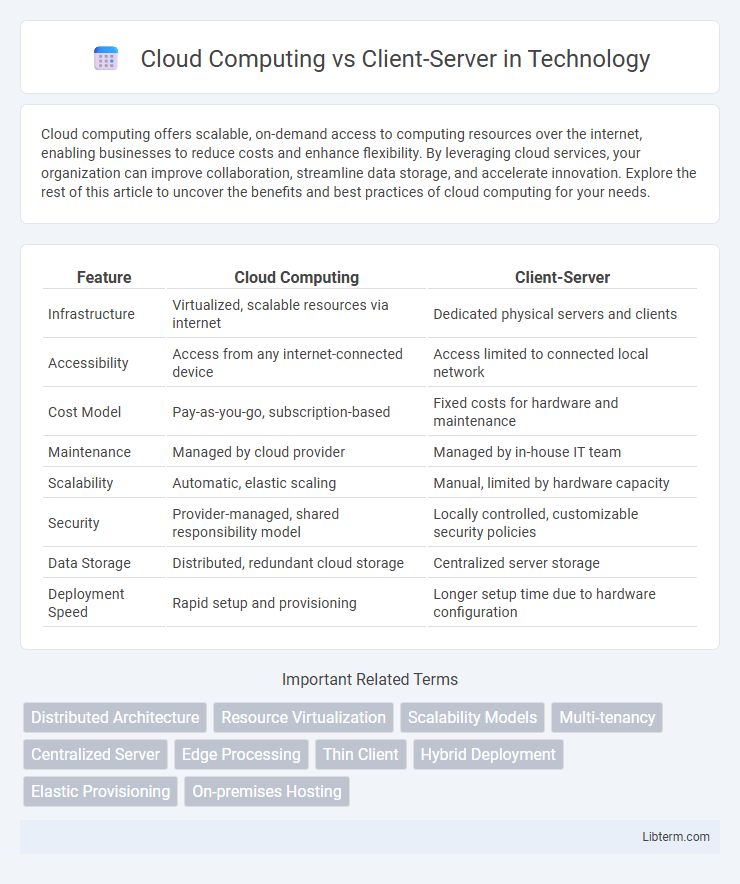Cloud computing offers scalable, on-demand access to computing resources over the internet, enabling businesses to reduce costs and enhance flexibility. By leveraging cloud services, your organization can improve collaboration, streamline data storage, and accelerate innovation. Explore the rest of this article to uncover the benefits and best practices of cloud computing for your needs.
Table of Comparison
| Feature | Cloud Computing | Client-Server |
|---|---|---|
| Infrastructure | Virtualized, scalable resources via internet | Dedicated physical servers and clients |
| Accessibility | Access from any internet-connected device | Access limited to connected local network |
| Cost Model | Pay-as-you-go, subscription-based | Fixed costs for hardware and maintenance |
| Maintenance | Managed by cloud provider | Managed by in-house IT team |
| Scalability | Automatic, elastic scaling | Manual, limited by hardware capacity |
| Security | Provider-managed, shared responsibility model | Locally controlled, customizable security policies |
| Data Storage | Distributed, redundant cloud storage | Centralized server storage |
| Deployment Speed | Rapid setup and provisioning | Longer setup time due to hardware configuration |
Introduction to Cloud Computing and Client-Server Models
Cloud computing delivers on-demand access to shared computing resources over the internet, enabling scalable storage, processing power, and software applications without local infrastructure dependency. The client-server model involves a centralized server providing resources and services to multiple client devices within a network, relying on direct connections and dedicated hardware. Cloud computing extends the client-server concept by leveraging virtualization and distributed data centers to offer flexible, pay-as-you-go services accessible globally.
Core Architecture: Cloud Computing vs Client-Server
Cloud computing architecture relies on distributed resources hosted on remote servers accessed via the internet, enabling scalability and on-demand resource allocation. Client-server architecture involves a dedicated server providing resources or services directly to client machines within a localized network, typically limiting scalability. The core distinction lies in cloud computing's elastic, multi-tenant infrastructure compared to the fixed, single-tenant setup of traditional client-server models.
Deployment and Accessibility Differences
Cloud computing offers on-demand deployment through internet-based servers, enabling global accessibility and scalability without local infrastructure. In contrast, client-server architecture relies on fixed physical servers within a network, limiting accessibility to specific locations and requiring manual deployment. Cloud platforms support dynamic resource allocation and remote access, whereas client-server systems often necessitate significant client-side setup and maintenance.
Scalability and Resource Management
Cloud computing offers superior scalability by dynamically allocating resources based on demand, enabling efficient handling of varying workloads without the need for physical infrastructure changes. In contrast, traditional client-server models rely on fixed hardware capacity, limiting scalability and often resulting in resource underutilization or bottlenecks during peak usage. Cloud environments utilize virtualization and automation to optimize resource management, reducing operational costs and improving system performance compared to the manual scaling and resource allocation typical in client-server setups.
Cost Efficiency and Pricing Models
Cloud computing offers cost efficiency through scalable pay-as-you-go pricing models, eliminating upfront hardware investments and reducing maintenance expenses. Client-server architecture typically incurs higher initial costs for server acquisition and ongoing expenses for physical infrastructure management. The cloud's flexible, usage-based pricing contrasts with the fixed costs and capacity limitations of traditional client-server setups, making it more cost-effective for dynamic workloads.
Security and Data Protection
Cloud computing offers advanced security measures such as encryption, multi-factor authentication, and continuous monitoring to protect data across distributed environments. Client-server architectures rely heavily on securing the server and internal network perimeter, making them more vulnerable to insider threats and localized breaches. Cloud providers implement robust compliance standards like GDPR and HIPAA, ensuring greater data protection and regulatory adherence compared to conventional client-server models.
Performance and Reliability Considerations
Cloud computing offers enhanced performance and reliability through scalable resources and global data centers that reduce latency and ensure continuous uptime. Client-server architecture relies on localized servers, which may face bottlenecks and single points of failure, impacting performance during peak loads. Cloud services often include built-in redundancy and failover mechanisms, providing higher availability and disaster recovery capabilities compared to traditional client-server setups.
Maintenance and Upgrades
Cloud computing offers centralized maintenance and automatic upgrades managed by service providers, reducing downtime and eliminating the need for in-house IT staff to handle updates. Client-server architectures require manual maintenance and upgrades on individual servers and client machines, increasing time, costs, and complexity. Cloud environments provide scalability and continuous deployment, ensuring seamless performance enhancements without disruption.
Use Cases and Industry Applications
Cloud computing enables scalable, on-demand access to computing resources, making it ideal for industries like e-commerce, healthcare, and finance that require flexible data storage and real-time analytics. Client-server architecture suits applications needing direct, secure control over local resources, commonly found in banking systems, internal enterprise applications, and legacy systems. The choice between cloud computing and client-server depends on factors such as scalability, security requirements, and operational cost-effectiveness within specific industry use cases.
Choosing the Right Model: Key Decision Factors
Choosing the right model between cloud computing and client-server architecture depends on factors such as scalability, cost-efficiency, and maintenance complexity. Cloud computing offers dynamic resource allocation and reduced upfront investment, ideal for businesses requiring flexibility and global access. Client-server models provide greater control and security, favoring organizations with stringent data governance and predictable workloads.
Cloud Computing Infographic

 libterm.com
libterm.com